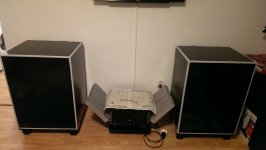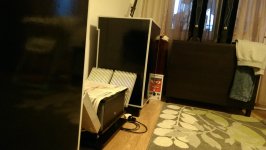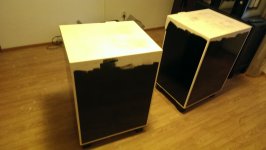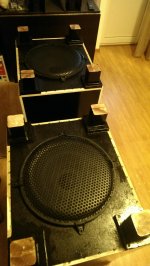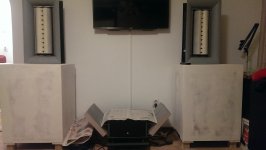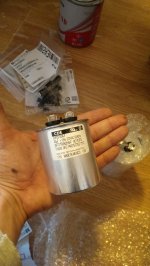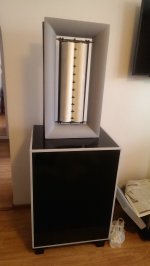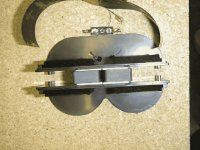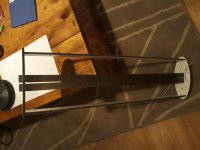I do not know if it's good with the bass speaker facing the floor. The speakers must be coupled to the floor, but in your case the pressure that is formed will push up the speakers. A mp3 bass test from youtube show you what I say.
Thanks Vlad,
You are perfectly right and i know what you are saying, but that is the case for bellow 6 cm (the bass was insane and making me sick and the woofer membrane was moving hard). I measured it and listened and readjust and then fineadjust.. After a couple of trial days i came to the 10cm sollution. Look at support feets, they are 5 pcs made from 2 cm plywood (i dont know how its named in english) resulting10cm. Now, at 10cm, the woofer membrane its barely moving when its facing the floor (about 1 to 2mm maximum from a total of 5mm xmax) at half volume (19w) on an youtube bass test, it looks like it moves like its upfiring. Now the bass is just perfect for my listening sessions (i love especially live concerts, jaz, vocals, opera, vocal trance and rarely som rap).
Vlad, your observation would have been good if i had posted what i wanted to do from the begining and asking some advice...it would have saved me allot of time (no kidding).
Thanks
Woo serg those bins are insanely bigyou must be able to give a party for sure when they are done ! I myself are working on these YouTube itsy bitsy smaller hehe

I shure do. I cannot go higher than 10-15w without being in the other room or with some cottone in the ears.
Those speakers of yours Wrine are indeed something. I just love them. They sound gorgeus and that is the music that i like most. Cant whait to see what encloshure you make for them.
Cheers
Sergiu
Here they are. The bass speakers are almost ready. Still have to wait to completely dry. I have used enameled black this time. Looks pretty good, better than the pics are showing. Still waiting for the other components to arrive from different suppliers.
Attachments
looking good serg ! kind of a PA meets high endBIG bold sub! nice paint btw high gloss ?
Thank you my friend,
Yup, high gloss enamel black.
Hi Olegsan,
Yes you can, but then you have to take into account that you have to optimise your metal plates accordingly to get a sufficiently high flux for high efficiency. As an example, please take a look at the pic that i posted bellow from the net with a disassembled Lineaum tweeter (wich is practically a small rubanoid speaker).
Here you can see how thin the plates are to get sufficient efficiency with smaller ( inevitably weaker) magnets.
In the past i have tested with succes smaller ruba membranes on my 52cm gap and my conclusion was: the smaller the ruban membrane the higher it goes with the rolloff point. To be more explicit: with my final 50cm membrane (as i use it now) i can go as low as 150hz (tested) then roll off, but prefered to actually cut it at 220hz (a matter of taste), but with a 25cm long membrane the speaker rolled of in the 600-650hz region.
So if you go smaller you will get actually a very good tweeter (very airy, smooth, opened and detailed) but in this case you will have a real headake with the vertical dispersion. Then you can deal with the verticall dispersion easily with some copper wires and a simple square frame..
Cheers
Sergiu
Yes you can, but then you have to take into account that you have to optimise your metal plates accordingly to get a sufficiently high flux for high efficiency. As an example, please take a look at the pic that i posted bellow from the net with a disassembled Lineaum tweeter (wich is practically a small rubanoid speaker).
Here you can see how thin the plates are to get sufficient efficiency with smaller ( inevitably weaker) magnets.
In the past i have tested with succes smaller ruba membranes on my 52cm gap and my conclusion was: the smaller the ruban membrane the higher it goes with the rolloff point. To be more explicit: with my final 50cm membrane (as i use it now) i can go as low as 150hz (tested) then roll off, but prefered to actually cut it at 220hz (a matter of taste), but with a 25cm long membrane the speaker rolled of in the 600-650hz region.
So if you go smaller you will get actually a very good tweeter (very airy, smooth, opened and detailed) but in this case you will have a real headake with the vertical dispersion. Then you can deal with the verticall dispersion easily with some copper wires and a simple square frame..
Cheers
Sergiu
Attachments
Hello Sergiu.
Thank you very much for your answer.
I have magnets 50х10х10 (from the past project-tape high-frequency)
If I apply these magnets do I need to reduce the thickness of the plates? (I plan to use 6 mm).
Do you recommend reeling the reel? (I understood correctly?)
Bud do 15 cm RUBANOID, I need a good mid-range speaker.
Thank you very much for your answer.
I have magnets 50х10х10 (from the past project-tape high-frequency)
If I apply these magnets do I need to reduce the thickness of the plates? (I plan to use 6 mm).
Do you recommend reeling the reel? (I understood correctly?)
Bud do 15 cm RUBANOID, I need a good mid-range speaker.
Hello Sergiu.
Thank you very much for your answer.
I have magnets 50х10х10 (from the past project-tape high-frequency)
If I apply these magnets do I need to reduce the thickness of the plates? (I plan to use 6 mm).
Do you recommend reeling the reel? (I understood correctly?)
I will make 15 cm RUBANOID, I need a good mid-range speaker.

Last edited:
Hello Sergiu.
Thank you very much for your answer.
I have magnets 50х10х10 (from the past project-tape high-frequency)
If I apply these magnets do I need to reduce the thickness of the plates? (I plan to use 6 mm).
Do you recommend reeling the reel? (I understood correctly?)
Bud do 15 cm RUBANOID, I need a good mid-range speaker.
Yup. Try 6mm and see if its not bending. If it is, try to reinforce it with a U shape copper on the back.
What reeling the reel? Please be more explicit.
I like aluminium over copper wire but in your case i dont think you will find such thin aluminium foil to get at least 4ohm. I think very thin copper wire is the way for 10-15cm ruban. But first try aluminium and see how much ohms you get.Hello Sergiu.
You recommend winding the coil with a wire.
Or do you like aluminum foil?
Hello Sergiu.
I think that with copper wire it will be easier for me to make a coil. And the wind is easier and the resistance is easier to calculate.
You glue the foil on the membrane and cut it out on it ( it is difficult for me). Rather, the RUBANOID will be 20 cm. (If all the magnets are completely intact)
I do not know if I will lose power because of the narrow wire coil in comparison with the wide foil.
I think that with copper wire it will be easier for me to make a coil. And the wind is easier and the resistance is easier to calculate.
You glue the foil on the membrane and cut it out on it ( it is difficult for me). Rather, the RUBANOID will be 20 cm. (If all the magnets are completely intact)
I do not know if I will lose power because of the narrow wire coil in comparison with the wide foil.
Hello Sergiu.
I think that with copper wire it will be easier for me to make a coil. And the wind is easier and the resistance is easier to calculate.
You glue the foil on the membrane and cut it out on it ( it is difficult for me). Rather, the RUBANOID will be 20 cm. (If all the magnets are completely intact)
I do not know if I will lose power because of the narrow wire coil in comparison with the wide foil.
it is al about current and amount of turns. as long as the conductor are in the magnetic field it does not mater how wide or thin they are. the trick is to get as much windings while retaining a 4 ohm load for instance and the ability to get to 20Khz (weight) thats why alumnium has a preverence.
weight is 45% less with the same current capability. so you can add 40% more turns. doubling turns and keeping resistance the same gives you 3dB more output !
Hello my friend. Thats a pretty high ruba.. Did you managed to keep them staight?The problem with 10mm did a magnets is the fact your metal is 10 wide unless you use the sideways.
Here 4 pieces of steel 20x10x600 bender by only 40x20x1mm magnets
Gap was 3.5 mm now 0
Cheers
it is al about current and amount of turns. as long as the conductor are in the magnetic field it does not mater how wide or thin they are. the trick is to get as much windings while retaining a 4 ohm load for instance and the ability to get to 20Khz (weight) thats why alumnium has a preverence.
weight is 45% less with the same current capability. so you can add 40% more turns. doubling turns and keeping resistance the same gives you 3dB more output !
Actually in the case of the ruba it does matter how large the traces of the coil are vs the magnetic motor, gap and membrane ( this aspect has to be experimented and fine tunned accordingly). If they get larger you get a more linear frecv response (measured) and they sound better soundwise ( abit more cleaner) . I think that it has to do with the surface area of the coil that is in contact with the paper and the transmitance of the sound to the membrane and the ability of the paper or material used for the membrane to tame the peaks and smoothen the overall frecv responce.
I didnt measure any dB in plus or heard the sound twice as loud (the 3dB in plus) when doubling the turns and keeping the same impedance... If you look a couple of pages back you will find that i made coils with thinner traces and higher impedances and coils with more turns and thicker traces and 1:1 coil and larger traces with lower impedances and other combinations mentionned and unmentionned and in each case i perceived the same amount of dB when the coil produced same impedance, more dB when lower impedance (for the jlh69 amp) and fewer dB with higher impedance. The only thing that changed was the frecv responce here and there and the excursion abit wich inevitably affected the overall sound signature and balance.
I spoke with an ex physics college professor and he sugested to increase the magnet force with stronger magnets or optimise the steel plates to increase flux and keep low mass on the coil to get more efficiency and i think that he is 100% right because now that i have smaller plates and the steel is strictly bonded on the magnets and a few mm in plus facing the oposite pole, i perceive more dB, and measured more dB, but at the begining, when i had bigger steel plates on both sides and the magnetic field was sprouting everywhere, the results where negative (efficiency speaking) exaclty as our colleague Solhaga and others have simulated.
After all this journey with the rubas, if i where to go from scratch again or buy new speakers (i hope not, never) i would deffinetly aim for the highest SPL and not wats of power.
Cheers
Sergiu
Hi Serg !
more turns is more force , just how it works in magnetnetics going up in turns thus increasing resistance will net in no gain no lose. if you bring back that impedance you will gain. yes it does mean you got more weight more turns of thicker wire weighs more
going up in turns thus increasing resistance will net in no gain no lose. if you bring back that impedance you will gain. yes it does mean you got more weight more turns of thicker wire weighs more 
good point about the surface area. although i made fast version yesterday with wire al packed together and response was the same. i think the V shape ***** up more of the high end then anything else to be honest of mic i reached 18 khz in the middle it gets bumpy
of mic i reached 18 khz in the middle it gets bumpy 
more turns is more force , just how it works in magnetnetics
good point about the surface area. although i made fast version yesterday with wire al packed together and response was the same. i think the V shape ***** up more of the high end then anything else to be honest
- Home
- Loudspeakers
- Planars & Exotics
- A DIY Ribbon Speaker of a different Kind
